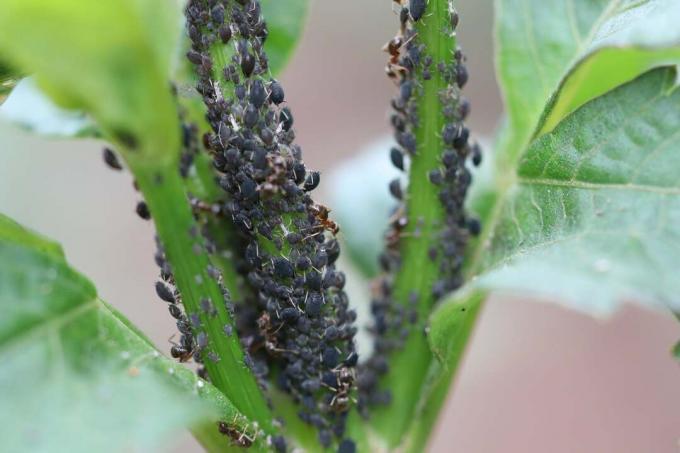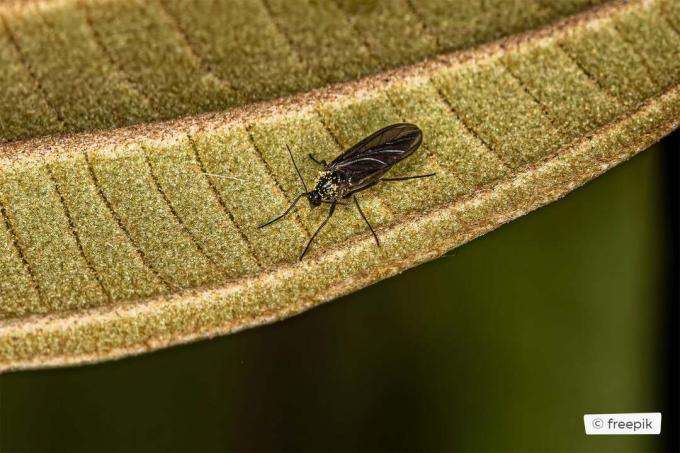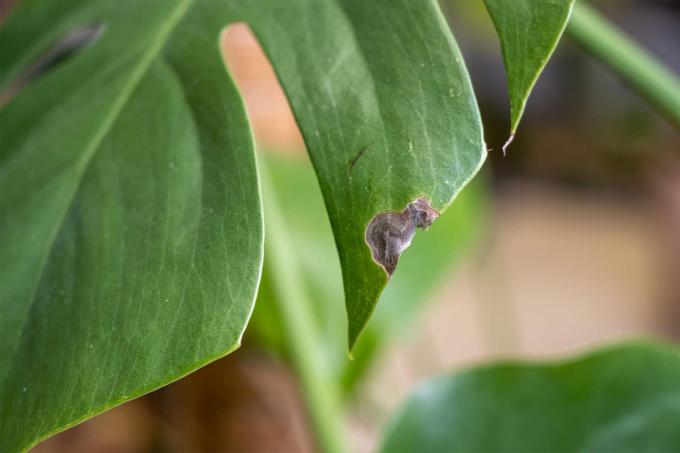
Small black dots on a plant do not bode well. You should therefore quickly search for the cause in order to avert serious damage. We present possible causes.
In a nutshell
- Various causes of small black dots on plants
- Plant death possible if left untreated
- Research the cause and initiate countermeasures
Table of contents
- aphids
- Fight
- thrips
- Fight
- fungus gnats
- Fight
- leaf spot disease
- Fight
- excretions
- frequently asked Questions
aphids
aphids (Aphidoidea) feed on the sap of plants. Their maximum body length is seven millimeters. Therefore, individual animals are often perceived as black dots on plants. The plague only becomes clearly visible when the lice have formed colonies due to their explosive reproduction.

Fight
To prevent spreading, the affected plant must be isolated immediately. The further procedure depends on the severity of the infestation. If you only find a few animals, it is often sufficient to crush them. If the measure has no effect, the following home remedies have proven themselves in the fight against the plague:
- stick the peeled clove of garlic into the substrate
- Spray the plant regularly with garlic or oregano brew (do not forget the underside of the leaves)
- houseplant with Spray on potash-suds (not tolerated by all plants)
- Dishwashing liquid for spraying
- Insert ladybug larvae
A notice: Before you Aphids with a home remedy to get to grips with it, you should cut off heavily infested parts of the plant.
thrips
thrips (thrips) are tiny insects. Since they grow to a maximum of three millimeters in size, they are perceived by the human eye as small black dots. The pests are mainly found on the underside of the leaf. Their larvae are white to light green. If the infestation is left untreated, it can mean the death of the plant.

A notice: Thrips love dry warmth. Therefore, the risk of infestation is greatest in summer and at the beginning of the heating season.
Fight
The most effective way to go is with a soapy solution against the pests. To do this, dissolve eight grams of soft soap in half a liter of water:
- Wipe the plant thoroughly with the soapy water
- Repeat the process regularly over several weeks
- Mist larger houseplants with an emulsion of olive oil (four tablespoons), water (two liters), and a dash of dish soap
- Spray the plant every two to three days
- shower the plant regularly
fungus gnats
fungus gnats (Sciaridae) are tiny flying insects that take off when you water the houseplant. In appearance and size, they can be compared to fruit flies. However, they are not after your fruit, but your houseplants. In addition, it is not the adult animals, but their offspring that are the real danger for the plants. Because the larvae feed on the roots. In addition, a female lays up to 200 eggs in the substrate. Since the life expectancy of the animals is only a few days, there is an almost explosive increase that can kill the houseplant.

A notice: Fungus gnats usually infest houseplants that have been watered too much. However, they can also be introduced by new plants or poor-quality substrate that already contains eggs.
Fight
Since fungus gnats are able to fly, you should isolate the affected houseplant before taking any further action. In quarantine, proceed as follows:
- Cover substrate surface with quartz sand (one to two centimeters)
- prevents further oviposition
- Set up yellow boards (reduces the adult animals)
- two to three stick burnt matches into the substrate (head down)
- kills the larvae
A notice: If the infestation cannot be contained, you must replace the contaminated substrate. Rinse the roots under lukewarm water to completely remove the old soil. Put the houseplant in fresh substrate and a new pot.
leaf spot disease
Leaf spot disease is a plant disease that can be seen as small black dots in the early stages. Fungi, viruses or bacteria are possible pathogens, with the former being the most common cause.

Fight
The only way to combat leaf spot disease is to radically cut back all affected parts of the plant. Dispose of the clippings in the residual waste, as the pathogens in the compost can survive for several years.
excretions
If you notice small black dots on a plant, it could also be thrips droppings or other pests. Examine the houseplant closely to determine the cause. Then initiate the appropriate countermeasures.
- wipe the affected leaves
- Alternatively: shower off
- does not damage the plant
frequently asked Questions
You can make your plants more resistant to pests and other diseases with the right care. The right choice of location, the ambient temperature and the humidity in the room are particularly important. The increase humidity, succeeds with just a few tricks. Fertilizers before winter will also help your pets along.
Since there is a possibility with purchased soil that fungus gnats and other insect eggs are in it. It is advisable to sterilize the soil before use. To do this, put the earth on a tray and put it in the oven at approx. 150 to 200 degrees for 20 - 30 minutes. Alternatively, you can also carry out this process in the microwave. To do this, put the soil in a container that is also suitable for the microwave. Slightly moisten the soil and leave it for approx. 10 minutes at 500-600 watts in it.
To ensure that diseases cannot be transmitted through the pruning of your plants, it is important to pay attention to appropriate hygiene. The pruning shears should be poured over with boiling water before use. Alternatively, you can also carry out this process using spirit, alcohol, tea tree oil or vinegar essence. In the garden market there are also special sprays that can be used for this process. Furthermore, in order to prevent injuries to the plant, you should sharp secateurs regard.



